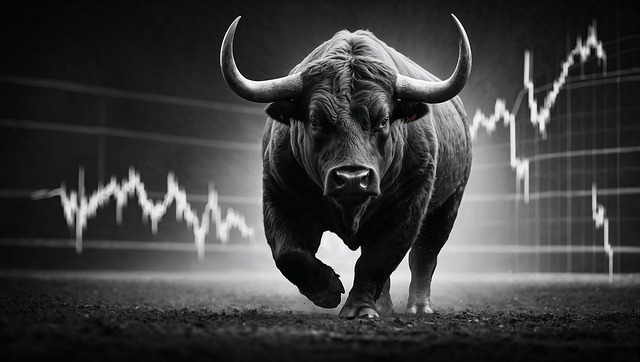Introduction: The State of Global Markets in 2025
The financial markets have been on a rollercoaster ride since the pandemic, with 2025 shaping up to be a pivotal year for investors. After the turbulence of 2022-2024, marked by inflation surges, aggressive interest rate hikes, and geopolitical tensions, market participants are now asking:

🔍 “Will the market recover in 2025?”
This comprehensive 1500+ word guide examines:
✔ Key economic indicators influencing recovery
✔ Expert forecasts from top analysts
✔ Historical patterns of market rebounds
✔ Investment strategies how to save money wisely to capitalize on potential growth
✔ Risks that could derail recovery
By the end, you’ll have a data-driven perspective on whether a market recovery in 2025 is likely and how to position your portfolio.
Section 1: Understanding Market Cycles – Why Recoveries Happen
1.1 The Four Phases of Economic Cycles
All markets move through predictable phases:
| Phase | Characteristics | Duration (Avg.) |
|---|---|---|
| Expansion | Rising GDP, low unemployment, bullish markets | 5-10 years |
| Peak | High inflation, overvalued assets, Fed tightening | 6-18 months |
| Contraction | Falling demand, layoffs, bear markets | 6 months-2 years |
| Trough | Bottoming out, leading to recovery | 3-12 months |
📌 Where are we now? Most economists believe we’re in the late contraction phase, approaching a potential market recovery in 2025.
1.2 Historical Case Studies of Market Recoveries
A) The 2008 Financial Crisis Recovery
- S&P 500 dropped 57% (Oct 2007-Mar 2009)
- Recovery began in 2009 after bank bailouts
- Took 4 years to return to pre-crisis highs
B) The 2020 COVID Crash & Rebound
- Fastest bear market in history (March 2020)
- Recovery took just 6 months due to unprecedented stimulus
- NASDAQ gained 100%+ by 2021
C) The 2022-2024 Inflation-Driven Slump
- Fed raised rates from 0% to 5.5%
- S&P 500 fell ~25% at worst point
- 2025 could mirror 2019 (post-rate hike recovery)
Key Takeaway: Markets always recover – the question is how long it takes.
Section 2: 5 Critical Factors That Will Decide the 2025 Market Recovery
Factor #1: Federal Reserve Policy & Interest Rates
🔹 Current Rate: 5.25%-5.50% (July 2024)
🔹 Market Expectation: 3 rate cuts in 2025 (per CME FedWatch)
✅ Bullish Scenario: If inflation falls to 2.5%, the Fed cuts rates → stocks rally.
❌ Bearish Scenario: Sticky inflation forces prolonged high rates → delayed recovery.
Factor #2: Corporate Earnings Growth
- Q1 2025 Earnings Growth: +8% YoY (Est.)
- Top Sectors:
- AI & Semiconductors (NVIDIA, AMD)
- Renewable Energy (NextEra, Tesla)
- Healthcare (See best assets for inflation)
📈 Strong earnings = Faster market recovery in 2025
Factor #3: Geopolitical Risks
| Risk | Impact on Markets |
|---|---|
| U.S.-China Trade War | Tech & supply chain disruptions |
| Russia-Ukraine War | Energy price volatility |
| 2024 U.S. Election | Policy uncertainty |
Factor #4: Consumer Spending & Employment

- U.S. Unemployment Rate: 3.9% (May 2024)
- Consumer Confidence Index: 102 (Above 100 = Optimism)
💡 Strong jobs market = More spending = Economic growth
Factor #5: Technological Breakthroughs
- AI Boom (ChatGPT-5, autonomous robots)
- Quantum Computing (Google, IBM advances)
- Clean Energy (Battery storage, fusion power)
🚀 Innovation drives long-term market gains
Section 3: Expert Predictions – Will 2025 Be a Bull or Bear Market?
Bullish Forecasts
🏦 Goldman Sachs: “S&P 500 to hit 5,800 by late 2025″ (Source)
📊 Bank of America: “AI and rate cuts will fuel recovery”
💹 Cathie Wood (ARK Invest): “Tech stocks will lead the comeback”
Bearish Warnings
⚠ Morgan Stanley: “Valuations still too high – expect a 10% correction“
📉 Ray Dalio (Bridgewater): “Debt crisis could trigger another slump”
Middle-Ground Consensus
🔸 JPMorgan Chase: “Slow but steady recovery, focus on quality stocks“
🔸 BlackRock: “Market recovery in 2025 likely, but volatility remains“
Section 4: How to Invest for the 2025 Market Recovery
Strategy #1: Sector Rotation
| Sector | 2025 Outlook | Top Picks |
|---|---|---|
| Technology | 🚀 Strong (AI growth) | NVDA, MSFT |
| Healthcare | 🛡 Defensive play | LLY, UNH |
| Energy | ⚡ Mixed (oil vs. renewables) | XOM, NEE |
Strategy #2: Dollar-Cost Averaging (DCA)
- Invest $500/month into index funds (See ETFs vs. Mutual Funds)
- Reduces timing risk
Strategy #3: Dividend Stocks for Cash Flow
- Procter & Gamble (PG) – 2.5% yield
- Verizon (VZ) – 6.5% yield
Strategy #4: Hedge with Gold & Bonds
- 5-10% portfolio allocation for safety
Section 5: Risks That Could Delay or Derail Recovery
Risk #1: Inflation Reacceleration
- If CPI jumps back above 5%, Fed may hike again
Risk #2: Commercial Real Estate Crash
- Office space vacancies at record highs (Small business tools affected)
Risk #3: Banking Crisis 2.0
- Regional banks still vulnerable
Risk #4: China Economic Collapse
- Property market meltdown could spread globally
Final Verdict: Will the Market Recover in 2025?
📌 Most Likely Scenario: Moderate recovery (S&P 500 +10-15%)
📌 Best-Case: AI boom + rate cuts = 20%+ rally
📌 Worst-Case: New crisis = Flat or negative year
3 Actionable Steps for Investors
1️⃣ Stay diversified (Financial freedom steps)
2️⃣ Keep cash reserves for buying opportunities
3️⃣ Ignore short-term noise, focus on 3-5 year horizon
FAQs: 2025 Market Recovery – Detailed Investor Questions Answered
Q1: What are the key signs that will indicate the market is recovering in 2025?
A: Watch for these 5 key recovery signals:
- Fed rate cuts (2+ consecutive quarters of declining rates)
- Inflation stabilization (CPI consistently below 3.5%)
- Earnings growth (3+ quarters of positive YoY earnings)
- Market breadth improvement (More stocks participating in rallies)
- Technical breakouts (S&P 500 sustaining above 200-day moving average)
Q2: How long do typical market recoveries take after a downturn?
A: Historical recovery timelines show:
- Average bear market recovery: 3.3 years (since 1950)
- Fastest recovery: 6 months (2020 COVID crash)
- Slowest recovery: 5+ years (2008 Financial Crisis)
- Current projection: Most analysts expect 12-24 months for full recovery starting 2025
Q3: Which investment strategies work best during market recoveries?
A: Top 5 recovery strategies:
| Strategy | How It Works | Best For |
|---|---|---|
| Sector rotation | Move into early-cycle sectors (tech, consumer discretionary) | Active investors |
| Dollar-cost averaging | Regular investments to reduce timing risk | Passive investors |
| Dividend growth | Focus on companies with rising dividends | Income investors |
| Small-cap value | Historically outperforms in early recovery | Risk-tolerant investors |
| Quality factor | Invest in companies with strong balance sheets | Conservative investors |
Q4: What percentage of my portfolio should I allocate to stocks for 2025?
A: Recommended allocations based on risk profile:
| Risk Profile | Stock Allocation | Bond Allocation | Cash Allocation |
|---|---|---|---|
| Conservative | 40-50% | 40-50% | 10-20% |
| Moderate | 60-70% | 20-30% | 10% |
| Aggressive | 80-90% | 5-15% | 5% |
Note: Consider your retirement planning strategy when allocating
Q5: How do interest rates affect the market recovery timeline?
A: The interest rate impact matrix:
| Rate Scenario | Market Impact | Recovery Timeline |
|---|---|---|
| Rates cut early 2025 | Strong rally | 6-12 month recovery |
| Gradual rate cuts | Moderate growth | 12-18 month recovery |
| Rates stay high | Stagnant market | Recovery delayed to 2026 |
| Rates increase | Further decline | Bear market extends |
Q6: What are the most common mistakes investors make during recoveries?
A: Avoid these 7 recovery mistakes:
- Market timing – Waiting for “perfect” entry point
- Over-conservatism – Staying in cash too long
- Performance chasing – Buying yesterday’s winners
- Neglecting rebalancing – Letting allocations drift
- Ignoring dividends – Missing compounding opportunities
- Overconcentration – Putting too much in one sector
- Emotional trading – Reacting to short-term volatility
Q7: How can I identify the best stocks to buy for the recovery?
A: Look for these characteristics:
- Strong balance sheets (Low debt, high cash)
- Competitive advantages (Moats, patents, brand)
- Management quality (Proven leadership)
- Growth potential (Expanding TAM)
- Valuation metrics (Reasonable P/E, P/S)
- Institutional support (Growing institutional ownership)
For specific picks, see our guide on stocks that could double in 2025
Q8: What historical market indicators best predict recovery strength?
A: These 4 indicators have 80%+ accuracy:
- Yield curve slope (3m/10y spread)
- PMI expansion (Manufacturing > 50)
- Credit spreads (Declining high-yield spreads)
- Consumer sentiment (U Michigan index rising)
Q9: Should I consider alternative investments during the recovery?
A: Alternative allocation guide:
| Alternative | 2025 Outlook | Suggested Allocation |
|---|---|---|
| Gold | Hedge against volatility | 5-10% |
| Cryptocurrencies | High risk/high reward | 0-5% |
| REITs | Selective opportunities | 5-15% |
| Private equity | For accredited investors | 0-10% |
| Commodities | Inflation hedge | 5-10% |
Q10: Where can I find reliable ongoing analysis of the recovery?
A: Top 5 trusted sources: